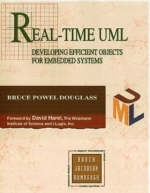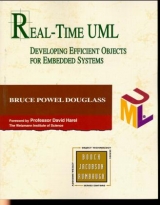
Real-Time UML
Addison Wesley (Verlag)
978-0-201-32579-9 (ISBN)
- Titel erscheint in neuer Auflage
- Artikel merken
Second Edition now available! Real-time systems programmers face unique challenges. Qualities such as execution speed and memory size are paramount in the development of real-time systems, and performance is a fundamental aspect of correctness in this domain. Given these constraints and requirements, it is fair to say that the development of real-time systems is more challenging than that of most software systems. Yet the lack of a standard notation and design process has discouraged embedded systems developers from adopting a revolutionary new approach to software design--object technology--that has produced clearly identifiable benefits in less specialized software applications. With the development and wide adoption of a standard notation, the Unified Modified Language (UML), real-time systems developers can now avail themselves of the benefits and advantages of object technology. UML is a 3rd generation modeling language which rigorously defines the semantics of the object metamodel and provides a notation for capturing and communicating object structure and behavior. It is particularly well-suited to modeling real-time and embedded systems.Real-Time UML is the introduction that developers of real-time systems need to make the transition to object-oriented analysis and design and modeling with UML.
It covers the important features of the UML and shows how to effectively use the UML to model real-time systems. The book includes special in-depth discussions of finite state machines, object identification strategies, and real-time design patterns to help beginning and experienced developers alike. 0201325799B04062001
Bruce Powel Douglass is the Chief Evangelist for i-Logix, a leading producer of tools for real-time systems development. He contributed to the original specification of the UML and to the UML 2.0 as one of the co-chairs of the Object Management Group’s Real-Time Analysis and Design Working Group. Bruce consults for a number of companies and organizations, including NASA, on building large-scale, real-time, safety-critical systems. He is the author of seven other books, including Real-Time Design Patterns (Addison-Wesley, 2003) and Doing Hard Time (Addison-Wesley, 1999).
1. Introduction to Real-Time Systems and Objects. What is Special about Real-Tim Systems? Dealing with Time. Advantage of Objects. Object Orientation with UML. UML Diagrams and Notation. A Look Ahead. References. 2. Requirements Analysis of Real-Time Systems. External Events. Specifying External Events. Use Cases. Scenarios. Context Diagrams and Use Cases in Real-Tim Systems. References. 3. Analysis: Defining the Object Structure. The Object Discovery Process. Key Strategies for Object-Oriented Analysis. Identify Object Associations. Object Attributes. Class Utilities. Verifying the Problem Statement. Discovering Candidate Classes. Class Diagrams. Defining Class Relationships and Associations. Associations. Aggregation and Composition. Associative Classes. Generalization Relationships. Summary. References. 4. Analysis: Defining Object Behavior. Object Behavior. Defining Object State Behavior. UML State Diagrams. The Role of Scenarios in the Definition of Behavior. Defining Operations. Summary. References. 5. Architectural Design. Overview of Design. What is Architectural Design? Representing Physical Architecture in UML. Architectural Patterns. Communication Infrastructure. Concurrency Design. Representing Tasks. Defining Task Threads. Assigning Objects to Tasks. Defining Task Rendezvous. Summary. References. 6. Mechanistic Design. What is Mechanistic Design? Mechanistic Design Patterns. Summary. References. 7. Detailed Design. What is Detailed Design? Data Structure. Associations. Operations. Visibility. Algorithms. Exceptions. Summary. References. Appendix: Notational Summary. Index
| Erscheint lt. Verlag | 3.2.1998 |
|---|---|
| Verlagsort | Boston |
| Sprache | englisch |
| Maße | 187 x 234 mm |
| Gewicht | 680 g |
| Themenwelt | Mathematik / Informatik ► Informatik ► Programmiersprachen / -werkzeuge |
| Informatik ► Software Entwicklung ► Objektorientierung | |
| ISBN-10 | 0-201-32579-9 / 0201325799 |
| ISBN-13 | 978-0-201-32579-9 / 9780201325799 |
| Zustand | Neuware |
| Haben Sie eine Frage zum Produkt? |
aus dem Bereich



